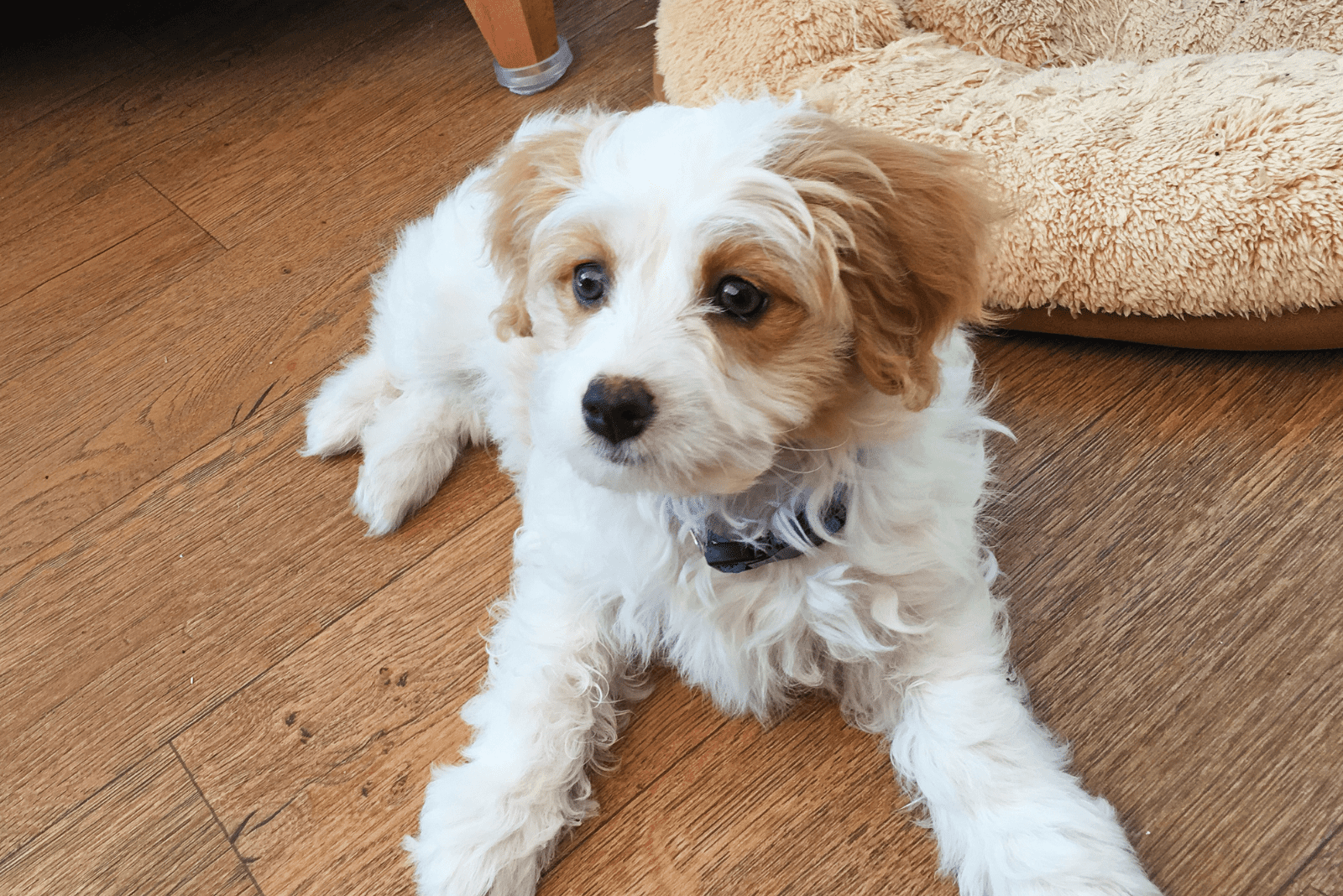You may think that the cavachon does not get as many original traits as the purebred dogs. Just the opposite – this puppy, being a mixed breed, has one of the most unique and charming characters among puppies.
Together with chihuahuas, cavapoos, goldendoodles, bullmastiffs, or french bulldogs they belong to a small dog club. You, however, may think that the cavachon puppy, being a small breed, is a low-energy doggie.
On the contrary, the cavachons are playful and sassy little canines, ready to color your life and make it funnier!
However, just like any other small breed, keeping track of your cavachon puppy is essential! You may want to maintain a healthy weight of your puppy and make sure it doesn’t meet any severe health issues just because you didn’t know how to organize its feeding chart.
The Cavachon Growth Chart is specific and requires extra attention. You’re not quite sure about what it should look like? Let’s take a ride!
The Cavachon Growth Chart
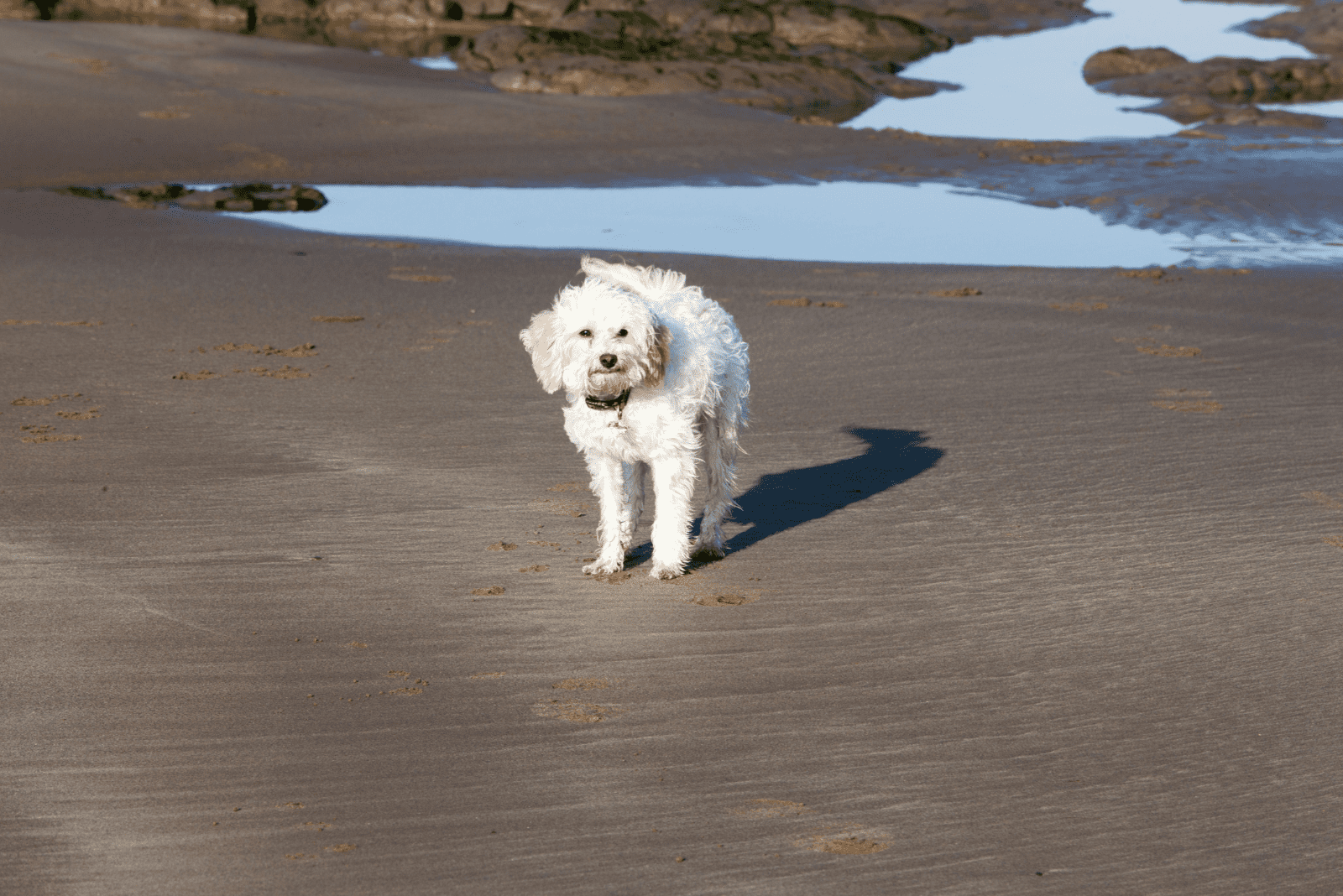
Do you have difficulties finding the cavachon growth chart? Well, truth to be told, this cute little doggy indeed belongs to the club of mixed breed puppies you probably didn’t know existed.
The Cavachon Growth Chart is a tool we use in order to analyze the possible weight of a puppy and predict the best average size of a cavachon in each life stage. Based on its birth weight, we estimate the future growth of a cavachon puppy through weeks, months, and, lastly, ages.
The Growth Chart helps us estimate the adult cavachon’s ideal weight and analyze potential health threats that the puppy might face.
However, the chart is only a prediction and these values are relative.
The Cavachon, being a crossbreed between the cavalier king charles spaniel and the bichon frise, weighs around 15 to 20 pounds and reaches no more than 12 inches in height.
This is the average size of the cavachon in its adulthood. Now let’s take a ride through the cavachon’s growth chart by age.
The Cavachon Growth Chart By Age
Even though we can find a universal puppy growth chart by age, it is better if we used the one specific for cavachons.
Below you can find the estimated weekly and monthly weights of your cavachon puppy. Take a note that the puppy reaches its adult weight when it’s 10-12 months of age. This weight has to be preserved in the latter stages of its life for the sake of their health.
The small dog breeds have to follow the exact growth chart in order to maintain the perfect physical balance and good energy levels.
Anything below 15 pounds in the adult size should be worrying and you need to find new ways to feed your puppy. The same goes if the cavachon puppy weighs over 20 pounds. The cavachon over 25 pounds in weight reached the obesity level and needs to be treated medically.
[table id=557 /]
The Cavachon Throughout Life Stages
In the following part we will explain the cavachon growth chart throughout each of its life stages. Take note that the cavachon’s development has to be carefully monitored in the earliest phase of its life, since this is the time where their feeding routine is established.
This little pooch develops fast which is a trait inherited from the parent breeds. Also, there are other design versions, like cavapoochon (cavalier+poodle+bichon frise) whose life stage is quite similar throughout phases. This goes for its intelligent and trainable nature, so the potty training and the basic commands are successfully learnt in the first weeks.
1-3 Weeks Old
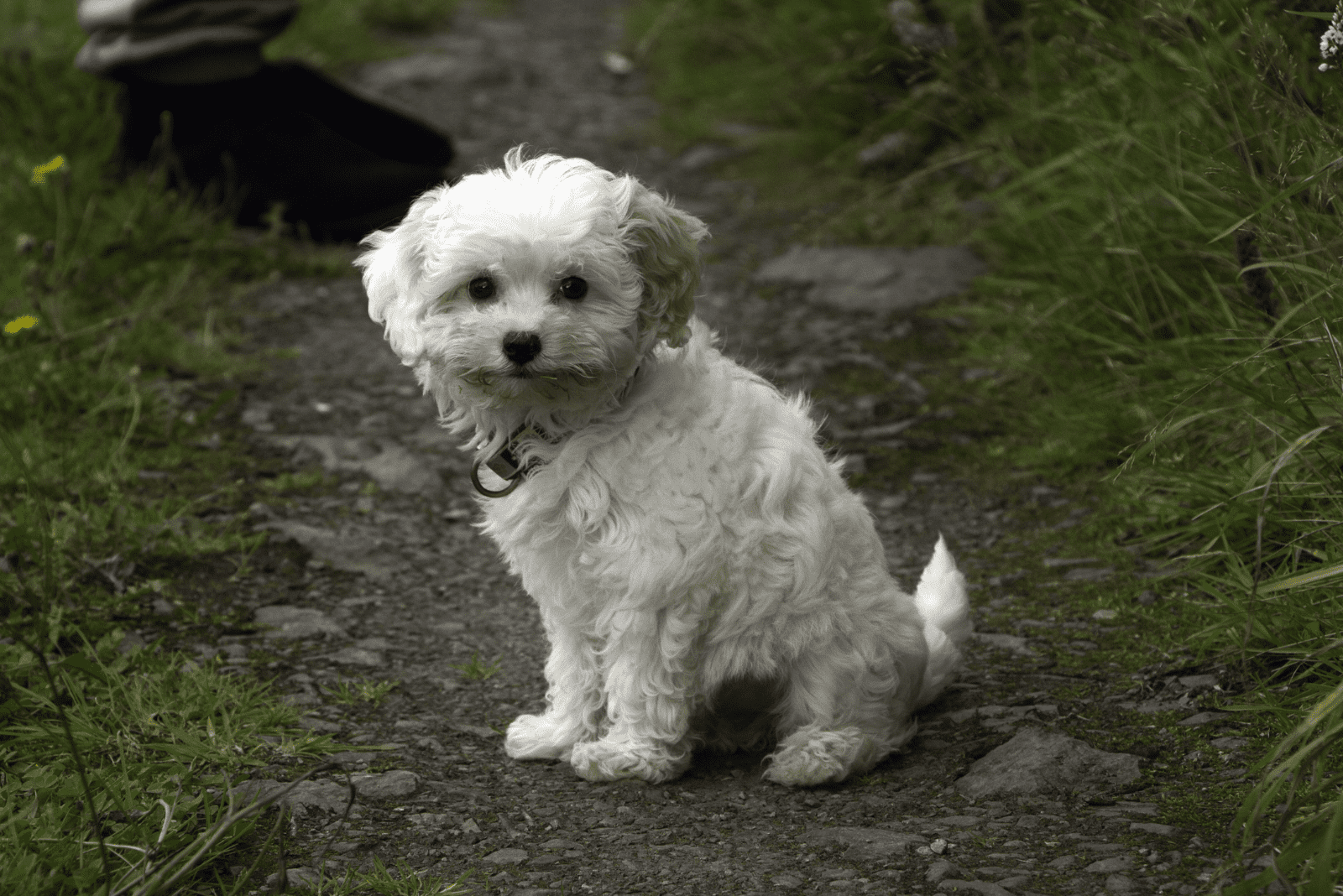
Baby cavachons are tiny little dogs and can easily fit into your hand. Being a small fluffy dog breed is a trait of both cavalier spaniel and bichon frise. They are only a few ounces heavy and the only thing required in their feeding chart is breastfeeding.
This is a tough period of a cavachon growth because these couple of weeks pass slowly and their weight is subject to many variations.
They weigh only 12-15 ounces, which means any decrease in their mom’s milk supply can be fatal. Make sure they always have access to breast milk. Big litters can be up to 8 puppies and in the crowd the weakest ones usually can’t find their mom on their own.
3-8 Weeks Old
After week two the puppy enters the phase of biggest changes. The cavachon growth changes significantly and they can double their size in less than two weeks.
This is a period when they reach 2-5 pounds in weight, open their eyes and start crawling. In the third week you can actually predict the coat coloring of your cavachon puppy. They come in various variants, but the most popular are apricot, white and brownish.
By the end of their first month they start the process of socialization. They are still breastfeeding, which is still the best dog food option. However, if you adopt a puppy from a breeder that is younger than 8 weeks, make sure you consult your vet about the proper feeding chart.
This mixed breed dog is a true human companion. The 3-8 weeks of age is a period perfect for crate training. You adopted a cavachon puppy from a kennel and decided to provide it with an indoor home? Now’s the time to start the adaptation process.
8 Weeks – 5 Months Old
You have just come home from a dog shelter and wonder about the cavachon growth chart? Take a close look at this part, because this is the age when most of the dog owners adopt their cuddle buddies.
The cavachon puppy is usually around 5-6 pounds of weight when brought from a breeder. They stopped breastfeeding and now they slowly adapt to dog food. First thing you need to do is to communicate with the breeder.
He will tell you everything about the food the cavachon puppy was using for the last week or two. The advice is to purchase the exact same brand for the first couple of days and then start the slow process of introducing the puppy to other foods.
It can be a snack in between meals, but the important thing is to keep a balanced diet and not to deviate from the cavachon growth chart plans. The dog weight has to be monitored daily. You don’t want to cause any health problems and with the proper diet your puppy can live a long and healthy life.
Health, if maintained through other segments, is a trait inherited from bichon frise, one of the healthiest dog breeds in the world.
A cavachon puppy that is several months old now can reach up to 12-15 pounds in weight. It is only several pounds away from reaching its full adultery phase in weight and you should prepare yourself for the upcoming status quo. This means there are no more variations in a feeding chart.
5-10 Months
This is the last period of time when weight gain is a benefit. Cavachon puppies now slowly start to transfer from 12-15 up to 20 pounds. These are not large dogs and bear in mind that 15 pounds is totally fine for a cavachon breed.
Their lifespan depends on the proper usage of food resources and if fed the right way, they can easily live 13-15 years.
By the sixth or seventh month your pet should already have a well-established, three-times-a-day meal plan. Occasional snack in between meals is fine, as long as it is protein based and low-calorie.
This is where they differ from the tall dog breeds, because they need an extra meal in order to maintain their energy level high. Cavachons are indeed cheerful and playful puppies, but their activity level exclusively depends on the amount of food they take.
So the advice is – don’t skip meals! Otherwise the cavachon puppy life quality will decrease.
10-18 Months
By the end of the first year and a half your cavachon puppy is no longer a puppy! So make sure this phase of your puppy’s life is the last audition for the following years. The cavachon growth chart by now is already established and all you need to do is stick to the schedule.
Be aware that any deviation from the standardized meal plan and scheduled activities can cause your puppy’s potential health problems. This includes a dog’s grainy poop, laziness and obesity.
If, however, your puppy is by character more active than a regular cavachon and prefers more than 20 minutes a day training, you can afford to spoil it with a healthy snack.
The Cavachon Adultery
The cavachon pooch enters adult age by the beginning of the 19th month.
The adult cavachon is a well-behaved dog easily adapted to new challenges and environments. This means this mixed breed won’t have any trouble following a well-planned meal schedule. He will actually love it, as long as it contains everything needed for a healthy, sometimes even homemade, balanced diet.
In this stage you will already know how cheerful and active the cavachon puppies are, so you can plan occasional snacks from time to time based on their activity level.
Once you have prepared a perfect cavachon growth chart, you have nothing to worry about. You can enjoy the ride and play along with your canine.
Why Is the Cavachon Puppy Weight Chart Important?

The cavachon growth chart helps you better organize your daily feeding routine. The puppy cavachon craves routine in everything, but the same goes for an adult dog. Prepare your puppy food based on proportional representation of macronutrients and avoid, if possible, the worst dog food on the market.
This is a tip any small dog owner should bear in his mind, because small breeds like havanese, beagles, pugs or cavachons can’t satisfy their eating habits with sufficient exercise.
On the other hand, the weight chart helps you detect the early stage of many health problems easier. The bloat, for instance! However, proper chart usage will provide you with more health prevention, which is a good thing.
Also, it will prevent your dog from reaching obesity levels and that is one of the most dangerous threats to your cavachon’s life.
Weight Chart In Big And Small Breeds
There’s a significant difference between the big and the small dog breeds. Their training routines and eating habits are uncorrelated, as well as their physical capacities.
Big Breeds
There are different types of dog breeds, but the most popular classification is: working dogs, guard dogs and family dogs. Watch dogs are mostly more active and crave more food. Some of them are: siberian huskies, rottweiler, border collie. On the other side, we have akita, great dane, or german shepherd as big guard dogs.
Their level of energy is high and a slightly changed feeding chart won’t do much harm.
On the other hand we have calmer variants popularly known as family dogs, like labradors, retrievers, standard poodles, or cocker spaniel.
These larger dogs are usually more of a calmer nature and demand fewer hours of exercise. Their feeding chart has to be strict, but, again, an extra treat here and there will not do much damage.
Small Breeds
Small dog breeds, like maltese and chihuahuas, demand a proper and timely schedule. The same goes for purebred and mixed breed puppies – their feeding charts have one thing in common – it has to be strict and timely.
This is exclusively due to their lower activity level. Since most of these are lap dogs, there is a thin line between a healthy lifestyle and obesity.
What Impacts Cavachon Puppy’s Growth
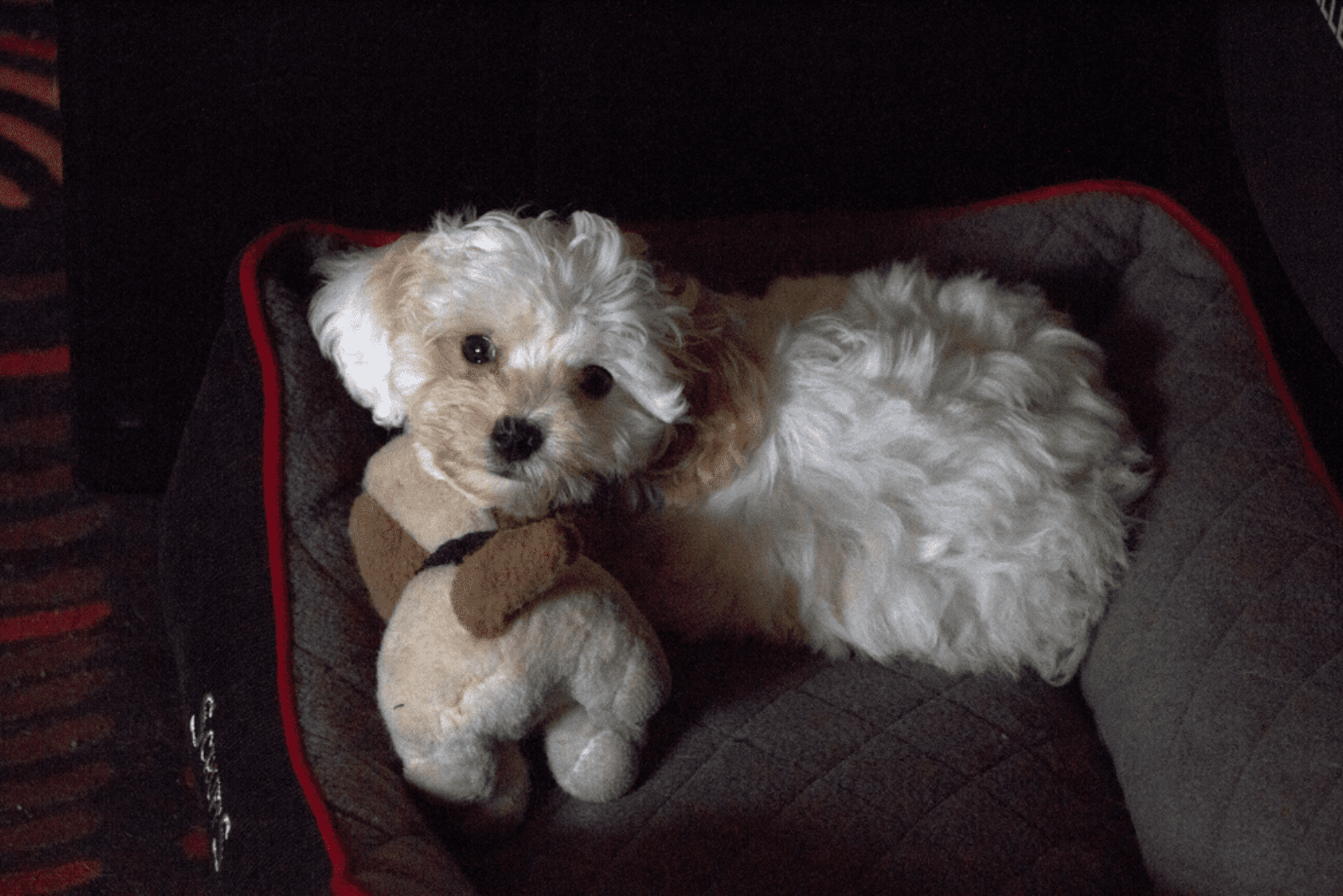
This is an extremely important issue to discuss, since there are several factors that impact the cavachon’s growth.
Every dog breed has a different growth path. The roots of their development are mostly relative, despite the universal rules established for each breed.
However, among the plethora of possible factors, I pointed out the three most important: their origin (parent breeds), the organization of their feeding habits and the type/amount of training on a daily basis.
Genetics and Parent Breeds
As a mixed breed, the cavachon has excellent genetics. This is inherited from the parent breeds. Both bichon frise and cavalier king charles are favorable for crossbreeding. In fact, the cavalier king charles dog mixes contain a variety of puppies that you don’t even know exist.
The breeders made sure this cute little canine inherits the best dog traits from each parent.
Both cavalier king charles spaniel and bichon frise have a relatively long lifespan and live a happy life. Aside from being playful, hypoallergenic and cute in their overall appearance, cavachon dogs are distinctively healthy dogs with little or no health issues.
Now let’s take a closer look at the cavachon parent breeds growth chart by month!
Cavalier King Charles Growth Chart
[table id=563 /]
Bichon Frise Growth Chart
[table id=564 /]
Feeding Habits
The feeding habit is the second most essential factor of impact when it comes to a cavachon growth chart.
Small dog breeds require more frequent meals and a well prepared feeding schedule. If your puppy follows these rules, it will probably go within the estimated growth chart in the upper part of this article.
Well-scheduled meal plans involve timely feeding, appropriate distance in between meals and, lastly, the quality food! There are times when a dog won’t eat dog food, but only treats. In these cases you should contact your veterinarian!
Note: Do not feed your puppy junk food, or your leftovers!
Timely feeding means preparing breakfast, lunch and dinner at the same time. Try to have dinner prepared at least 2 hours before the bed time of your cavachon puppy.
The appropriate distance in between meals should be at least 3-4 hours. This gives enough time for dog food to be processed properly.
Lastly, quality food is everything! The puppy, as well as the adult size cavachon needs proportional representation of protein, carbs and healthy fats.
Training
Cavachons demand a short, 20-30 minutes training of low intensity. This usually includes a relaxing walk outdoors, or a quick playtime in the backyard.
Small breeds do not need an exhausting training that lasts for hours. That’s more of a trait of large dogs, like Rottweilers, or german shepherds. They need this in order to maintain their calm attitude and friendliness. Otherwise, large breeds become aggressive and dangerous.
On the other hand, your cavachon buddy will be perfectly satisfied with cheerful legwork in the backyard. A simple ball might come in handy since it proved to be a real entertainer of this small breed.
However, if your puppy is going through the process of crate training, you can find plenty of activities inside the house to entertain your puppy.
How Long Do Cavachons Grow For?
Your cavachon puppy, just like any other dog breed, reaches its full potential after the first 18 months of age. This is the time they enter their adultery and get the adult size-shaped physique.
However, the cavachon tendency is to stop growing after the 10th month of its life. This is characteristic for its dog parent – a bichon frise. This is a relatively small breed, considered by many as a toy breed, too. That’s why they take less time to reach their maximum size.
When it comes to the universal growth chart, take a look at how dogs age.
Frequently Asked Questions
1.Do Cavachon Puppies Stay Small?
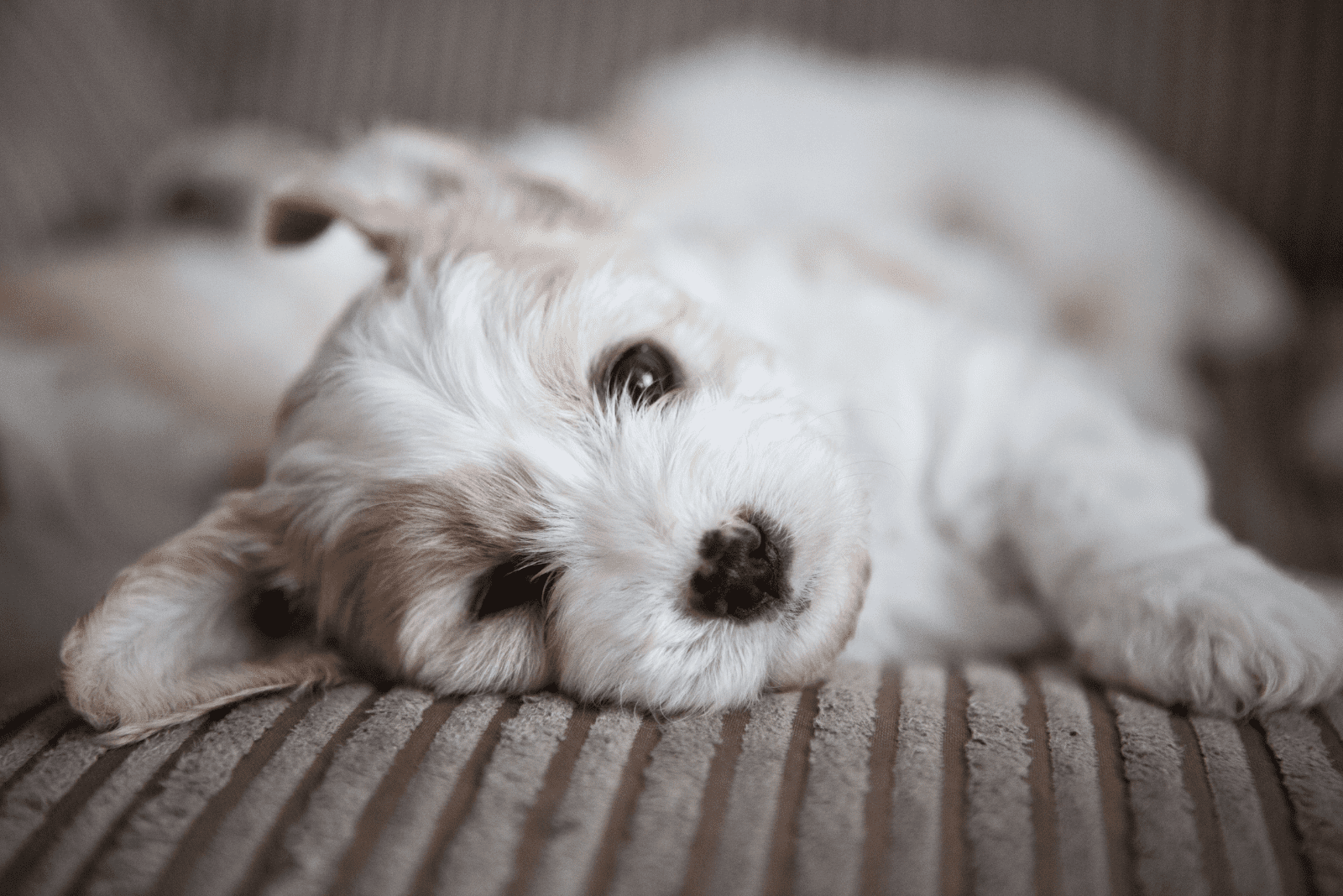
Yes!
Cavachon is, indeed, a small puppy at all times.
After the first few phases of their lives – the early puppyhood (1-3 weeks), the puppyhood (3-8 weeks) and the late puppyhood (8 weeks – 6 months), their growth slows down.
By the end of the 10th month the cavachon puppies do not grow anymore. There are, however, some cases where this might not be true, but that’s rare.
If you have difficulties realizing how big your dog is, consider comparing dog years to human years.
2.How Much Will My Cavachon Weigh?
It totally depends on you.
Your Cavachon, ideally, weighs around 15-20 pounds. Even 20 for some cavachons is too much, if we take into consideration that some cavachon puppies genetically can’t reach more than 10 inches.
In these cases you need to be careful and lower the amount of food you are giving to your puppy. Obesity in dogs will instantly affect health in a bad way, decrease their activity levels and change their mood to the worse.
Cavachons, being good baby boys, in these cases can become self-destructive and face extreme depression.
So, there is no real answer to this question. What you need to do is take a look at the cavachon’s growth chart and find the ideal plan.
3.How Long Should A Cavachon Be Walked For?
The adult cavachon requires no more than a 30 minutes walk per day. Anything beyond that could exhaust your puppy and cause physical damage, or an injury. They could become dehydrated or face joint injuries.
On the other hand, if your dog isn’t walked daily, they might have a tendency to show a bit of aggression. It can be reflected in the fact that they won’t stop biting you.
However, there are some cavachon mixes that genetically require more than just 30 minutes. These are usually the breeds that inherited slightly more than 50 percent of one of their parent’s genes.
For example, the cavachon that naturally inclined more towards a cavalier king charles spaniel could by nature be more active and demand more variations in its daily routine. This is because the cavalier spaniel is famous as a royal puppy that likes the occasional off-book chase.
4. Can Cavachons be left alone for 8 hours?
Not recommended! The cavachon can sometimes be a real drama-queen. They are easily attached to the owner and do not deal well with separation.
This is a trait of a bichon frise, too – a cavachon’s parent.
You might consider adapting your daily schedule to this puppy, because detachment from the owner might have severe consequences. As an extremely intelligent dog, a cavachon can suffer severe separation anxiety issues and stress.
Conclusion
The cavachon growth chart is what you need in order to determine the proper feeding habits of your pet. Small breeds are explicitly prone to weight disbalance once their routine is disturbed.
These puppies are sensitive in their habits and need a lot of attention.
Study your cavachon well and be prepared to adapt! Once the healthy routine is established, you will have a lifetime of happiness!
Read next: Do Cavachons Shed? A Helpful Guide To A Messy Situation
